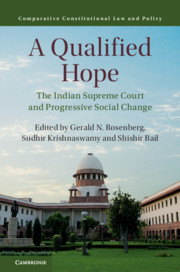Book contents
- A Qualified Hope
- Comparative Constitutional Law and Policy
- A Qualified Hope
- Copyright page
- Contents
- Notes on Contributors
- Foreword
- Acknowledgments
- Introduction
- Part I The Supreme Court of India – An Institutional Overview
- Part II The Supreme Court of India, Social and Political Mobilization
- Part III Welfare Rights and the Environment
- Part IV Discrimination
- Conclusion
- References
Part II - The Supreme Court of India, Social and Political Mobilization
Published online by Cambridge University Press: 19 August 2019
- A Qualified Hope
- Comparative Constitutional Law and Policy
- A Qualified Hope
- Copyright page
- Contents
- Notes on Contributors
- Foreword
- Acknowledgments
- Introduction
- Part I The Supreme Court of India – An Institutional Overview
- Part II The Supreme Court of India, Social and Political Mobilization
- Part III Welfare Rights and the Environment
- Part IV Discrimination
- Conclusion
- References
Summary
By the 1990s, India’s appellate courts had become closely involved in the regulation of street vending in several metropolitan cities. However, despite the frequent use of legal mechanisms by street vendor collectives, there has been little progress towards “formalization” of the street vending economy. To understand the limited impacts of legal intervention, it is necessary to examine the timing and the circumstances under which street vendor collectives first turned to judicial forums for protecting their livelihoods. Based on a historical examination of street vendor politics in Bombay and Madras, I show that legal mobilization in both instances was a response to serious threats faced by the political regimes that had previously shielded street vendors from dispossession and exploitation, rather than being a direct result of new legal opportunities (such as the emergence of public interest litigation). Since organized street vendors had a strong preference for maintaining the status quo, litigation was used as an effective method for buying time in the face of a hostile or uncertain political environment, even when the ultimate verdict was not likely to favor street vendors.
Keywords
- Type
- Chapter
- Information
- A Qualified HopeThe Indian Supreme Court and Progressive Social Change, pp. 149 - 240Publisher: Cambridge University PressPrint publication year: 2019
References
References
References
References
Cases
- 5
- Cited by



